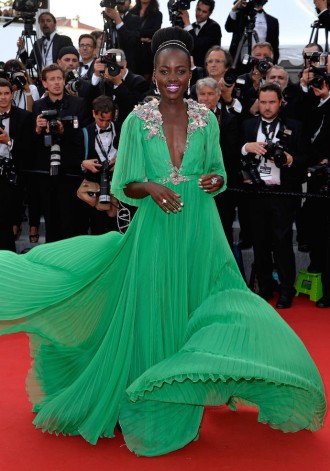Lizzie Velasquez And Sara Bordo On ‘A Brave Heart: The Lizzie Velasquez Story’ [EXCLUSIVE VIDEO]
Lizzie Velasquez, who was born with a rare genetic syndrome that makes it impossible to gain weight, let filmmaker Sara Bordo into her life in order to make the inspiring film A Brave Heart: The Lizzie Velasquez Story.
The Lizzie Velasquez Story
Growing up, Velasquez soon learned that there was something different about her. She went from doctor to doctor who couldn’t determine the disorder she was battling, and was bullied by her peers who were scared of the unfamiliar. Despite that, Velasquez managed to embrace life and become a vivacious teen.
“Once I got older, I started putting myself in situations that were a little bit scary, trying out for the cheerleading squad, joining other clubs or organizations that my friends weren’t in,” Velasquez told uInterview in an exclusive interview. “As scary as it was, I just really wanted to learn who I was as a person. And, over time, continuing to do that more and more, I think that’s what led to me being able to really come out of my shell.”
Bullied As ‘Ugliest Woman In The World’
However, at 17, Velasquez’s confidence took a major blow when she came upon a YouTube video that labeled her “the world’s ugliest woman.”
“I felt like I had worked so hard to get to this certain level of confidence that I had and I was procrastinating doing homework, just looking to play a song on YouTube and I saw a picture on the right hand side of the screen that looked a little bit familiar,” said Velasquez. “When I clicked on it, I didn’t know that it was going to change my entire life. I saw ‘the world’s ugliest woman’ title, saw that there were over four million views and thousands of comments, and within 2.5 seconds all of that confidence that I had worked so hard to build was just gone.”
Since then, Velasquez has rebuilt her confidence has now hopes to inspire others. It was while giving an inspirational speech at the Ted Austin Women Event in 2013 that Velasquez captured the attention of Bordo. Following the event, Velasquez and Bordo became fast friends, and were both amazed with how Velasquez’s Ted Talk had gone viral.
“Once we found out and watched this amazing wildfire that was catching after Lizzie’s talk got posted online we started to see this incredible openness that people were really responding to her in a fashion that they needed her recipe of hope; they needed to get in their own life what Lizzie had lived through,” Bordo told uInterview.
“I approached Lizzie and said I know this is crazy because I haven’t done a film before and you’ve been asked 10 times by a lot more experienced filmmakers than I, but I really believe I know exactly how to tell this story and I promised her parents that I would take care of her,” Bordo added.
During the course of filming the documentary, Velasquez, after all of those years, was finally given a concrete diagnosis – Neonatal Progeroid Syndrome – a rare form of Marfan syndrome that includes lipodytrophy. Though Bordo told Velasquez the emotional diagnosis didn’t have to be a part of the movie, Velasquez insisted.
“I knew right away I wanted it to be in the film. I wanted to of course get more answers for myself, but if I didn’t share it in the film I don’t think it would’ve been fair because I had already been so vulnerable up until that point,” Velasquez explained.
Bordo said, “It was important to me to show that Lizzie’s story, there is more than one way to deal with her experience.” Adding of how Velasquez persisted in her life instead of taking it, she said, “It was important for me to show that there is a choice and that Lizzie has gotten through the tunnel of bullying and is on the other side, and she is looking in trying to help other people out one at a time.”
A Brave Heart: The Lizzie Velasquez Story is currently in limited release.
Being diagnosed wasn’t something that was planned when we first started filming the movie. For 25 years I thought I was just going to forever be a question mark and not know what I had. And while we were filming my mom got a call from my genetic doctor and said, ‘We have an answer, we have a diagnosis.’ Sara was so incredibly kind in handling the situation and gave me the option of wanting to share it in the film or if I wanted to just keep it private. I knew right away I wanted it to be in the film. I wanted to of course get more answers for myself, but if I didn’t share it in the film I don’t think it would’ve been fair because I had already been so vulnerable up until that point.
My doctor sat us down, as you saw in the film, and explained everything in great detail and they were just very supportive and we now have an incredible team of doctors who has a game plan in place from now on. Scary as it was initially to know that I was gonna have some answers, it’s a lot more of a relief now.
I was diagnosed with Neonatal Progeroid Syndrome. It’s made up of Marfan and lipodystrophy. Although Marfan is fairly common, the specific kind that I have is very, very rare.
I was invited to produce and direct the first Ted Austin Women Event, which was in December of 2013. We met because Lizzie’s name came up very quickly when we started looking for hometown heroes. We became good friends after Ted, and I don’t think a film was anything that I had thought about doing, or you [Lizzie] had thought about doing. Once we found out and watched this amazing wildfire that was catching after Lizzie’s talk got posted online we started to see this incredible openness that people were really responding to her in a fashion that they needed her recipe of hope; they needed to get in their own life what Lizzie had lived through.
I approached Lizzie and said I know this is crazy because I haven’t done a film before and you’ve been asked 10 times by a lot more experienced filmmakers than I, but I really believe I know exactly how to tell this story and I promised her parents that I would take care of her.
My parents were so extremely incredible, so when I started school they never sent me on the first day with the notion of, ‘Prepare yourself other kids are gonna bully you or not know how to treat you.’ They sent me just being very encouraging and supportive, and I always just think of it as a really big wake up call for a five-year-old, because it was my first time to realize that I looked different and that bullying was a thing. Over time, I went from being really shy and upset about it to just being really frustrated around my middle school age because I just wanted to fit in. I just thought if I make a birthday wish or if I say a prayer that the next day I would wake up and look like everybody else, because in my mind I thought looking like everybody else would take away all of my problems.
Looking back now, I know that makes no sense now. Once I got older, I started putting myself in situations that were a little bit scary, trying out for the cheerleading squad, joining other clubs or organizations that my friends weren’t in. As scary as it was, I just really wanted to learn who I was as a person. And, over time, continuing to do that more and more, I think that’s what led to me being able to really come out of my shell.
I was 17 years old when I found the video. Up until that point I started high school and everything was really looking up. I had really great friends, I was really happy. I felt like I had worked so hard to get to this certain level of confidence that I had and I was procrastinating doing homework, just looking to play a song on YouTube and I saw a picture on the right hand side of the screen that looked a little bit familiar. When I clicked on it, I didn’t know that it was going to change my entire life. I saw the world’s ugliest woman title, saw that there were over four million views and thousands of comments, and within 2.5 seconds all of that confidence that I had worked so hard to build was just gone. It was non-existent.
I always tell people if you imagine yourself being in front of that computer screen and seeing your photo I think you know instantly exactly how I felt when I saw it.
One element that was really clear when we started talking to Lizzie and her family and other kids that had been bullied, it was very clear that Lizzie’s choice to forgive the bully and survive was an active one. But, there is an alternative, and that alternative is taken often. We learned of Tina Meier, the amazing Tina Meier and the story of her daughter Megan, who I think is with us, been a guiding hand throughout the film. She lived a similar upbringing as Lizzie but with a different experience and the same pain. She chose to leave us very early and she committed suicide when she was 13 after being bullied online. It was important to me to show that Lizzie’s story, there is more than one way to deal with her experience. It was important for me to show that there is a choice and that Lizzie has gotten through the tunnel of bullying and is on the other side, and she is looking in trying to help other people out one at a time.
RELATED ARTICLES
Get the most-revealing celebrity conversations with the uInterview podcast!

![Lizzie Velasquez And Sara Bordo On ‘A Brave Heart: The Lizzie Velasquez Story’ [EXCLUSIVE VIDEO]](https://cdn-o9.uinterview.com/wp-content/uploads/2015/09/news-lizzie-velasquez-director.jpg)

 Click here for the Cannes Film Festival 2015: Best Dressed Slideshow
Click here for the Cannes Film Festival 2015: Best Dressed Slideshow



Leave a comment